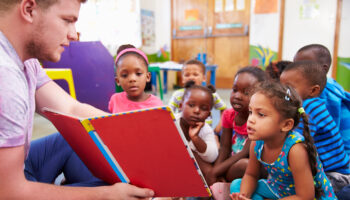Leah Zabari
Book review: It’s OK to Go UP the Slide by Heather Shumaker
As I was scanning the library shelves for a good book to read, I came across the book It’s OK to Go UP the Slide by Heather Shumaker. Man! Did I grab that book as quick as I could! I’ve always been a proponent of letting my own kids climb up the slide, living on the “dangerous” side of play, and after I read that title, it confirmed for me that others must think that way too. But it made me question why I never actually see it happening on the playground. Although the author talks about allowing children to go up the slide and the benefits of allowing children to take “healthy risks” as they explore, she also wrote about other topics that might be considered “out of the norm” but important subjects related to school. As an Early Childhood Educator, and believer in “playing to learn”, the chapter titled, Banish Calendars at Circle Time made me shout “AMEN” at a table in the very quiet library. I made a few heads turn with my excitement and I hope you will have that same reaction after hearing about her book.
Heather writes, “Circle time is that universal gather-on-the-rug-all-together time in front of the teacher. Done right, it boosts community and brings new ideas and joy. Dragged out – thirty, forty, forty-five minutes – circle time often bores kids and interrupts meaningful learning they could be doing.” I remember teaching circle time with songs, dancing, and games and then the dreaded word from my director came down and asked, “Where is your calendar?” UGH! So, I obediently went out and bought a circle time calendar. As soon as I started using an actual calendar during circle time, I noticed that within two minutes children were getting fidgety, not listening, and touching each other – which everyone knows (or should know) leads to behavior issues. I’ve heard it argued before, “The children learn numbers and counting during calendar time.” However, I think when doing the calendar and weather charts we are so focused on trying to teach counting and the days of the week song that we forget the importance of teaching kids in the present with tactile experiences (e.g., learning about the weather by taking walks and counting flower petals or how many clouds they can see). If you want to teach the weather, TAKE THE CHILDREN OUTSIDE! What better way to teach children about the weather than by taking them out in the drizzling rain, looking up at the sky to see that the clouds are gray when it rains, and then going on a rainbow hunt after the rain stops and pointing out that the clouds are white when it’s sunny while counting how many they can find. There are so many real-life activities to do outside to teach children about weather.
Don’t get me wrong, I love calendars! But I am an adult and I NEED one! If I didn’t have a calendar and schedule, who knows where I would be? The point is, kids will learn the days of the week, how to count and recognize numbers, different types of weather, and how to participate in a group time and use their “listening ears.” They will develop all the skills they need without the use of a thirty-minute calendar time.
Heather ends the chapter by pointing out that “Circle time in itself is precious. It feels good to be part of a human community, to sing together and gather for a puppet show or story. Save the best group activities – those that spark young minds – for the group. Let the rest go.”
In the chapter, “If you are ready to think beyond the calendar,” Heather gives tips on how to be successful in having circle time for your children. She asks her readers to decide what they truly believe is important about group time and what they hope to achieve. Just a few of her tips are “Make it short, make it meaningful, make it optional.” So, unless you are playing a game of Chutes and Ladders, it’s OKAY to go up the slide!
Shumaker, H. (2016). It’s OK to go up the slide. Renegade rules for raising confident and creative kids. New York, NY: Penguin.




